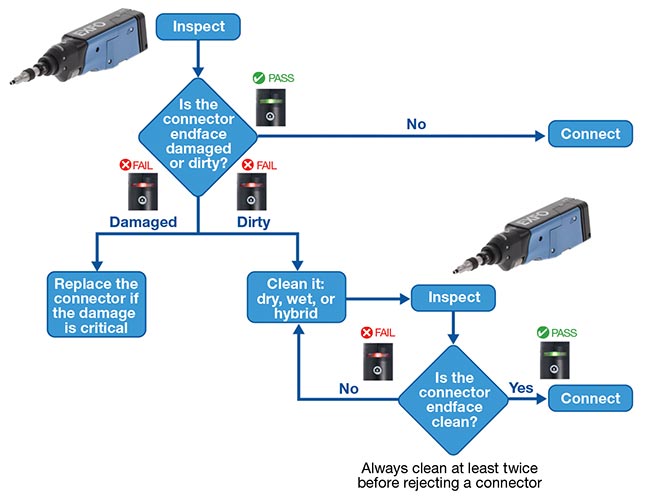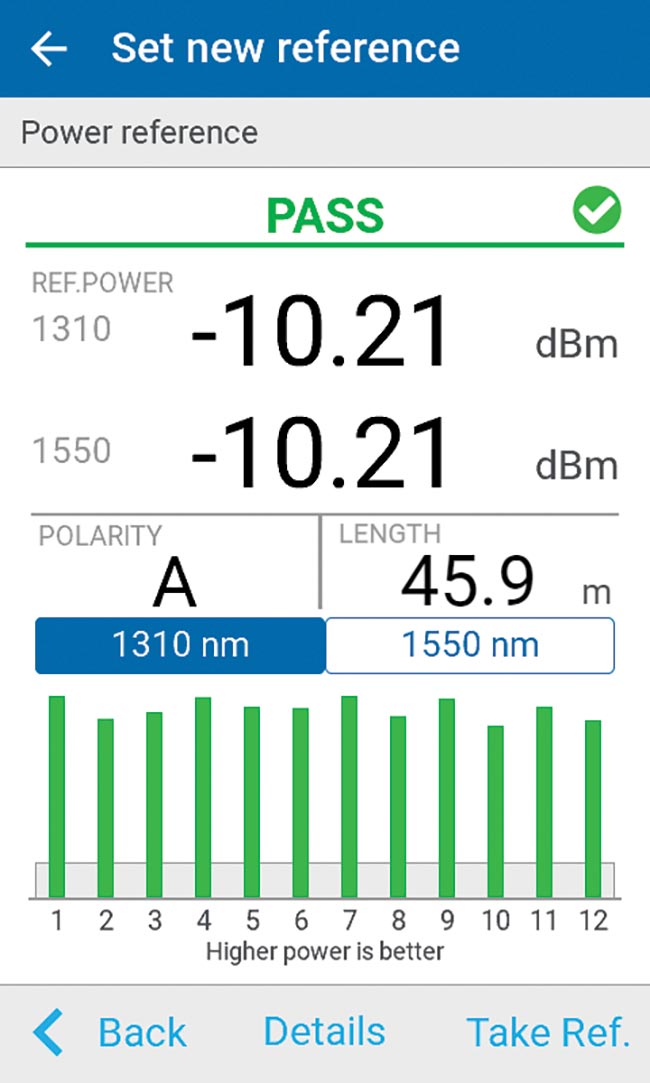NICHOLAS COLE, EXFO
You know how your headphone cables get tangled up in your bag just minutes after they were placed there neatly? And the Christmas tree lights, packed away carefully in January, emerge the next December in a nightmare of knots? You’re not imagining this phenomenon. Researchers at the University of Chicago have confirmed this happens through the scientific method of putting string in a box and jostling it about.

Proper maintenance of multifiber push-on (MPO) connectors is fundamental to support reliable, high-speed connectivity. Courtesy of EXFO.
Working with cables means constantly fighting against this chaos and entropy. It is something that network engineers are all too familiar with, and dealing with the demand for higher-speed and higher-density data transmission has further required them to look for upgrades to standard LC optical cables — an abbreviation deriving from the Lucent connectors developed by Lucent Technologies.
Proper maintenance of multifiber push-on (MPO) connectors is fundamental to support reliable, high-speed connectivity.
Multifiber push-on (MPO) connectors have been around since the 1980s, but their use in network applications has become increasingly common. These connectors (also labeled as MTP, a trademarked version that is compliant with the same standards) are used to enable high-speed connections and create redundancy. These capabilities derive from eight, 12, or 24 optical fibers that are incorporated into the cable that also reduce the number of cables necessary.
MPO cables are commonly described as plug-and-play components, but it is not quite that simple. The main source of signal loss in these multifiber links is their connectors, and failing to test and maintain these connectors can put the entire network at risk of costly downtime if they cause critical lines to be pulled for troubleshooting.
As the demand for greater network speeds increases and MPO connectors become even more common, it is vital to use best practices when testing these components.
Inspect before testing
Before testing even begins, check MPO connectors for any visible defects, damage, or contamination, such as dust, oil, and fingerprints. All of these defects can affect network performance. If connectors have damage or visible defects, they should be cleaned or replaced before testing begins.

Fiber connector inspection process. Courtesy of EXFO.
This is not intended to suggest that connectors should be cleaned regularly. Considering the delicate nature of MPO connectors, they should be cleaned only when it is necessary, with the use of a cleaning kit and without damaging any connectors.
Validate polarity
Most MPO jumpers and cables look alike, which can be confusing when it comes to judging their polarity. Polarity types A (straight), B (reversed), C (cross pair), and U (universal system) are easily confused and connectivity will break if the wrong one is used. Testing polarity, rather than relying on labels that may be incorrect, will ensure that this potential problem can be ruled out.
Use the correct reference method
It is important to use the correct reference method during the testing of MPO
connectors — given that they can significantly affect the accuracy of the test results. The best test method is the “one cord,” or method B, which allows the fiber optic link to be tested from end to end and the losses from each connector to be measured.
Though telecom technology evolves rapidly, the need to test and maintain these links is likely to be relevant for a long time to come.
But this may not always be possible. MPO connectors feature pinned as well as unpinned ends, which can require adapter cords to convert the MPO connector gender.
To reduce the risk of errors, MPO testers should feature embedded referencing wizards to guide technicians through every step of the selected referencing method.
Use and maintain reference cables
Proper test protocols require comparative evaluations against something that works reliably. Using reference cables establishes a baseline and helps ensure that test measurements are accurate. As with tested cables, reference cables must also be inspected and maintained to ensure accurate and repeatable results.
Using an unsuitable reference cable provides an unfavorable baseline and can lead to inaccurate results. Such results may be overly optimistic or unnecessarily pessimistic, which can lead to the improper identification of problems, or the unnecessary replacement of good cables. Using a tester with automatic reference level diagnostics can help ensure that appropriate methods are used, which enables accurate results and reduces confusion.



Multifiber push-on (MPO) cable polarity types. Courtesy of EXFO.
These reference cables need to be maintained because worn-out reference cords can greatly affect test results. For some reference and test methods, additional cords are inserted during the testing process and can also affect the test result.
Certain test methods that require an adapter cord do not include a test sequence to validate the adapter cord beforehand. Therefore, if technicians use a faulty adapter cord, test results will be inaccurate, which may lead to false test results. It is important to inspect both ends of a connection to avoid cross-contamination. The testing instrument’s optical testing port must also be routinely inspected and cleaned, particularly before each reference sequence.
Test at different wavelengths
Fiber optic networks use different wave-lengths of light to transmit data, and MPO connector performance can vary depending on the wavelength that is used. Testing on one wavelength will not give a full picture. Links must be tested at different wavelengths to ensure optimal performance. This is especially important for networks that use both single-mode and multimode fibers since performance can vary significantly between the two.
Regularly calibrate the tester
To achieve accurate measurements, regularly calibrate your testing apparatus to ensure that it accurately measures insertion loss and return loss. Calibration should be done based on the manufacturer’s recommendations and at regular intervals to ensure accurate measurements.
Documentation and training
Avoiding network downtime is a priority for data centers, and so it can be tempting to test, repair, and move on. But documentation is a vital part of maintenance and cannot be ignored. To track performance over time and identify repetitive issues, data center operators should
document test results for each MPO link that is installed. Documentation should include details such as the test date, the name of the tester, the reference method used, and the results that were obtained.
Without documentation, it is impossible to identify the root cause of recurrent problems or faults of previous tests.
Trying to save time by skipping this crucial step will lead to inefficiencies in the long term.

Dual wave referencing on 12F multifiber push-on (MPO) cables. Courtesy of EXFO.
All relevant staff need to be trained on proper test procedures and test documentation to ensure measurements are accurate and that optimal performance is achieved regardless of who performs the task. This includes training on proper cleaning and inspection procedures and using appropriate test configuration and reference cables. The good news is that test instruments are more and more intuitive and automated, which reduces the learning curve for new technicians and the risk of human error.
A further recommendation is to follow industry standards and guidelines for testing MPO connectors, such as those laid out by the Telecommunications Industry Association (TIA) and the International Electrotechnical Commission (IEC). Both provide guidelines for testing MPO connectors and other components of fiber optic networks.
MPO connectors are increasingly the connector of choice, and so testing and maintaining them is a major part of routine maintenance in any data center. The 12- and 24-fiber cable options are the most common. But more advanced cables incorporate 48 or even 72 fiber connections.
The demand for greater transmission speeds and capacities is unlikely to go away soon, which will only increase the demand on data centers to deliver more MPO connectors. Though telecom technology evolves rapidly, the need to test and maintain these links is likely to be relevant for a long time to come.